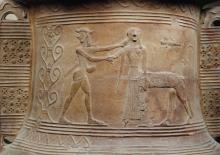A well-known relief pithos in the Louvre (CA 795) shows Perseus confronting a Gorgon whose human torso terminates in the body of a horse. Her equine features have proven difficult to explain, and earlier discussions of the scene have appealed to lost narratives, seventh-century artistic conventions and broad symbolic associations between Gorgons and horses. Focusing on her combination of equine and maidenly characteristics, this article interprets Medusa’s unusual form with reference to a series of ancient Greek metaphors connecting maidens, horses and Gorgons. It argues that recognizing the metaphorical logic of the image allows us to understand Medusa’s form as a sympathetic comment upon her death, which has parallels in the sacrifices of maidens in Greek art and literature.
